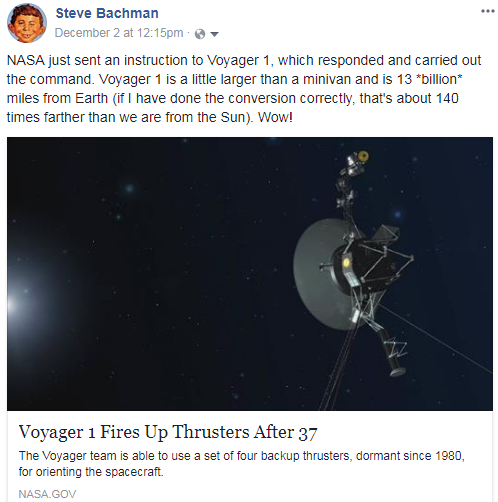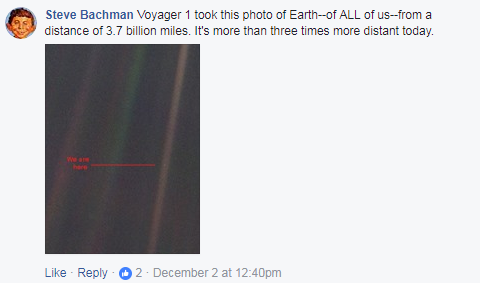Long Distance Call
Several days ago I was delighted and fascinated to read that NASA had sent a command to the Voyager 1 spacecraft and that it was received and its instructions were carried out successfully. Thrusters that had not fired in 37 years were used to make a small adjustment to the ship’s trajectory, an adjustment designed to facilitate an additional two to three years of communication between the spacecraft and NASA scientists here on Earth. Earth, the “pale blue dot” that has receded in Voyager’s rear view mirror to a distance of 13 billion miles.
I was compelled to share my enthusiasm on Facebook:

The image above includes a thumbnail from and link to NASA’s story Voyager 1 Fires Up Thrusters After 37 Years. It is a short, straightforward account of the maneuver and of the scientists and engineers at the JPL (Jet Propulsion Laboratory) who executed it. It’s worth reading.
Trivia (heads up to the Tinfoil Hat Brigade):
- The last time these thrusters were used was on November 8, 1980. Four days after Ronald Reagan was first elected President.
- According to my calculations (at least roughly correct, I think), Voyager 1 is 140 times farther from Earth than the Sun is.[1]
- It took the command sent by NASA more than 18 hours—traveling at the speed of light—to reach the spacecraft.
- When Voyager 1 is unable to relay data directly to earth, it can save (buffer) it in its 64K of memory. This is equivalent to the amount of RAM in an original 1980s Commodore 64 home computer. Modern smart phones, in addition to featuring processors many thousands of times faster than the spacecraft’s, contain at least 8GB of memory: 131,072 times more than Voyager’s 64K.
Click on the image above for a larger version of the famed “pale blue dot” photo of Earth taken in 1990 by Voyager 1. About this photo Carl Sagan wrote:[2]
Look again at that dot. That’s here. That’s home. That’s us. On it everyone you love, everyone you know, everyone you ever heard of, every human being who ever was, lived out their lives. The aggregate of our joy and suffering, thousands of confident religions, ideologies, and economic doctrines, every hunter and forager, every hero and coward, every creator and destroyer of civilization, every king and peasant, every young couple in love, every mother and father, hopeful child, inventor and explorer, every teacher of morals, every corrupt politician, every “superstar,” every “supreme leader,” every saint and sinner in the history of our species lived there—on a mote of dust suspended in a sunbeam.
More!
In a post just published, from my otherwise insufferable “ten books” series, I offer up some choice tidbits about Murmurs of Earth: Voyager, the Interstellar Record. This book tells the story of the gold-plated record albums traveling with Voyagers 1 & 2 to the stars. See Ten Books: 2017, Volume 3 for more.
Wikipedia’s Voyager 1 page is a treasure trove of information and features a sampling of beautiful photographs of our outer solar system.
—
Notes
- As it turns out, I needn’t have worried myself about the conversion. It’s done for me on the Wikipedia page on the mission. I was right. It’s good to know, at least, that I can correctly divide 13 billion by the value of one AU (astronomical unit). [^]
- From Carl Sagan’s Pale Blue Dot: A Vision of the Human Future in Space. [^]

